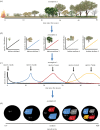Testing the assumptions of the pyrodiversity begets biodiversity hypothesis for termites in semi-arid Australia
- PMID: 29765661
- PMCID: PMC5936926
- DOI: 10.1098/rsos.172055
Testing the assumptions of the pyrodiversity begets biodiversity hypothesis for termites in semi-arid Australia
Abstract
Fire shapes the composition and functioning of ecosystems globally. In many regions, fire is actively managed to create diverse patch mosaics of fire-ages under the assumption that a diversity of post-fire-age classes will provide a greater variety of habitats, thereby enabling species with differing habitat requirements to coexist, and enhancing species diversity (the pyrodiversity begets biodiversity hypothesis). However, studies provide mixed support for this hypothesis. Here, using termite communities in a semi-arid region of southeast Australia, we test four key assumptions of the pyrodiversity begets biodiversity hypothesis (i) that fire shapes vegetation structure over sufficient time frames to influence species' occurrence, (ii) that animal species are linked to resources that are themselves shaped by fire and that peak at different times since fire, (iii) that species' probability of occurrence or abundance peaks at varying times since fire and (iv) that providing a diversity of fire-ages increases species diversity at the landscape scale. Termite species and habitat elements were sampled in 100 sites across a range of fire-ages, nested within 20 landscapes chosen to represent a gradient of low to high pyrodiversity. We used regression modelling to explore relationships between termites, habitat and fire. Fire affected two habitat elements (coarse woody debris and the cover of woody vegetation) that were associated with the probability of occurrence of three termite species and overall species richness, thus supporting the first two assumptions of the pyrodiversity hypothesis. However, this did not result in those species or species richness being affected by fire history per se. Consequently, landscapes with a low diversity of fire histories had similar numbers of termite species as landscapes with high pyrodiversity. Our work suggests that encouraging a diversity of fire-ages for enhancing termite species richness in this study region is not necessary.
Keywords: fire ecology; fire management; invertebrates; landscape heterogeneity; mallee; pyrodiversity.
Conflict of interest statement
We declare we have no competing interests.
Figures






References
-
- Bowman DM, et al. 2009. Fire in the Earth system. Science 324, 481–484. (doi:10.1126/science.1163886) - DOI - PubMed
-
- Kelly LT, Brotons L. 2017. Using fire to promote biodiversity. Science 355, 1264–1265. (doi:10.1126/science.aam7672) - DOI - PubMed
-
- Hale S, et al. 2016. Fire and climatic extremes shape mammal distributions in a fire-prone landscape. Divers. Distrib. 22, 1127–1138. (doi:10.1111/ddi.12471) - DOI
-
- Parr CL, Andersen AN. 2006. Patch mosaic burning for biodiversity conservation: a critique of the pyrodiversity paradigm. Conserv. Biol. 20, 1610–1619. (doi:10.1111/j.1523-1739.2006.00492.x) - DOI - PubMed
-
- Parr C, Brockett B. 1999. Patch-mosaic burning: a new paradigm for savanna fire management in protected areas? Koedoe 42, 117–130. (doi:10.4102/koedoe.v42i2.237) - DOI
Associated data
LinkOut - more resources
Full Text Sources
Other Literature Sources

